Abstract
Transport is an intersectoral complex that provides a material exchange of goods and services between business entities of the market and interpersonal relationships of the population. A huge role in the formation and development of efficient transport infrastructure is played by rail. It is the main mode of transport, and sometimes the only one, carrying passengers in any climatic conditions at any time of the year. When assessing the competitiveness of products, the integral quality of work must be supported by an assessment of the quality of specialized and additional services provided to customers. At present, during the modernization of the transport system of Russia, it is important to take into account the cumulative extra-transport effect obtained in various sectors of the economy, as well as in the areas of socio-economic life of the society from the functioning of transport. Actions are carried out before developing a competitive strategy. With information about the market situation and their own level of competitiveness, enterprises are able to make the right decisions about the strategy for further development. This article is devoted to the assessment of the main features, methods and stages of the competitiveness of enterprises of various types of transport. The authors disclosed approaches to assessing the competitive advantages of rail transport. The main types, stages and classification of the extra-transport effect of transport enterprises are presented.
Keywords: Transportextra-transport effectassessmentqualitycompetitiveness
Introduction
The socio-economic development of Russia requires the priority development of transport and the creation of conditions for the effective functioning of the transport market, provides opportunities for economic growth, increase the competitiveness of certain modes of transport and improve the quality of life of the population. The efficiency of the country's economy to a large extent depends on the efficient functioning of transport ( Tereshina, Abramov, Galaburda, & Ryshkov, 2002).
Problem Statement
The concept of reform and future development of railway transport allows selecting and justifying the relevant economic and social criteria and indicators. In the context of comprehensive globalization, transport competitiveness is an important category of a market economy. It characterizes the possibility and effectiveness of adapting enterprises to a competitive environment.
Research Questions
The development of methods for assessing the competitiveness of transport taking into account the extra-transport effect, the creation of strong competitive advantages are key tasks and determine the relevance of the chosen topic.
Purpose of the Study
The purpose of the study is to analyze the main methods and search for the perfect method for the assessment of the competitiveness of transport. Competitiveness characterizes the possibility and effectiveness of transport adaptation to the conditions of a competitive environment. To do this, it is necessary to use new and comprehensive methods to ensure competitiveness in order to create strong competitive advantages. The assessment of the competitiveness of railway transport is represented by approaches based on the theory of service quality management. The scientific school of transport production quality was created by professor Tereshina ( 2002).
Under the conditions of market relations, the competitiveness of a transport company characterizes the degree of development of the company and represents the ability to satisfy the solvent demand of customers in transportation of a certain volume and quality, which allows taking a leading place in the transport services market and get the most useful effect ( Bugreev, 2013). To ensure competitiveness and evaluate their activities, transport enterprises need to conduct a diagnosis of the competitive environment and the state of competition in the market, with the subsequent determination of promising areas for the development and functioning of the enterprise and the maintenance and improvement of its competitive advantages ( Balashova, Lipkina, & Balashova, 2015).
Research Methods
The set of methods for the assessment of the competitiveness of transport is classified according to the characteristics presented in Figure
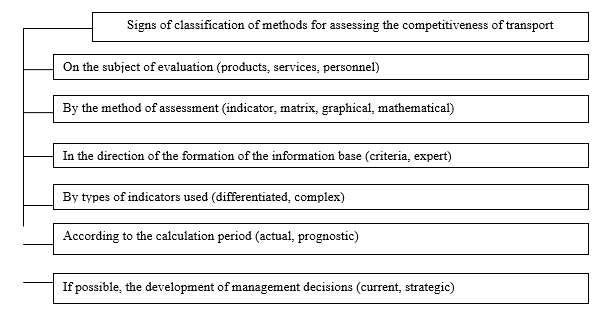
The use of the above mentioned features allows formulating the main methods for the assessment of the competitiveness of transport (table
Competitiveness is evaluated separately on the railway transport, and in comparison with other modes of transport. It should be noted that the quantity-quality-price ratio of transport services should be correlated.
Main competitive advantages of railway transport presented in figure
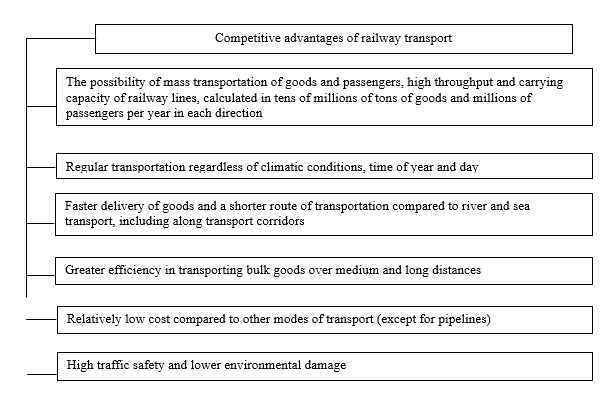
Table
Quality combined with the price of transport services for the client is the core of the concept of «competitiveness», which is the most important criterion for choosing decisions in the field of management. In order to streamline and rank information characteristics and parameters of objects, the method of rating ratings is widely used. This method can be used in the analysis of the competitiveness of both products and enterprises in the transport services market, for which an integral indicator of the development of the region should be determined. With it, you can really assess the level of potential competition between modes of transport and individual carriers.
Territorial features and the level of development of transport infrastructure lead to limited opportunities for the competition between railways and other modes of transport. The railway allows transporting goods of large volumes, various aggregate conditions and purposes, smaller volumes of products sold individually, are transported by trucks. In the near future, railway transport will be a leader in the field of transportation of bulk goods (raw materials and commercial products with a low degree of processing), as well as in various geographical segments of the market (at long distances, in regions with a low level of development of the transport network) ( Kravchenko, Perchatkin, & Laptiev, 2017).
The possibility of competition between railway transport and other modes of transport has a positive trend (table
The value of railway freight turnover in the 1st half of 2019 compared to the same period in 2018 increased by 2 % or 25.4 billion tons / km. The competitor of railway transport is road transport. The growth in road transportation in the 1st half of 2019 compared to railway transportation for the same period is 5.2 %. This is due to the increase in speed and ease of trucking by road. The growth of the fleet of the most diverse automobiles in terms of capabilities, the construction of roads, and the emergence of a large number of logistics companies specializing in trucking created the appearance of a wide territorial coverage of the country. The technological capabilities of the cars themselves have become much wider – low loader platforms with high carrying capacity and the availability of special means for loading and placing cargo may well compete with the railway platform. However, it is worth noting that rail transport is safer compared to road transport, since wagon departures are extremely rare compared to car accidents. The commercial success depends on the competent organization of transportation.
The dynamics of cargo turnover by means of transport in January-June 2019 and in January-June 2018 as % of the same period of the previous year is presented in Figure
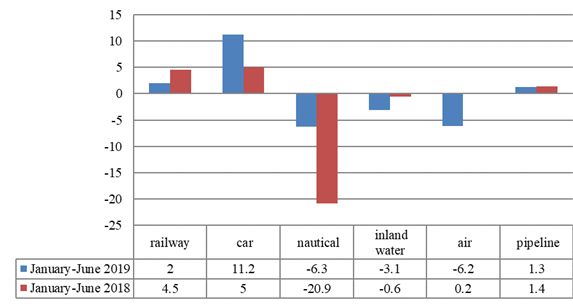
Competition began to grow with the advent of private business in the field of rail transportation; however, despite the achievements of relatively new participants in the freight transportation market, Russian Railways is still out of competition. Power over the entire railway infrastructure and ownership of the rolling stock fleet, which even all the wagons and locomotives of other companies combined cannot compare with. Russian Railways provides the most favorable conditions for the use of infrastructure due to the «discrimination» of private operators.
The extra-transport effect is defined as the benefits, associated effects or losses received in various areas of the socio-economic life of society as a result of the use of a particular type of transport and various transport technologies, but which do not affect the financial performance of transport organizations ( Sokolov, 2008).
The category of extra-transport effect includes the need to ensure the territorial integrity and national security of the state in the part that depends on transport ( Uskov, 2010).
Taking into account the extra-transport effect allows determining objectively the level of competitiveness. The stages of accounting for non-transport effect are presented in Figure
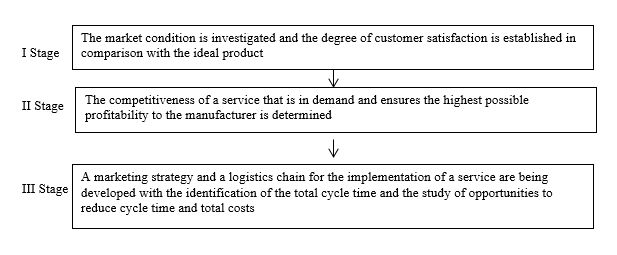
The following types of effects should be distinguished: reduction of working capital, reduction of the transport component in the price of products, improvement of cargo safety, reduction of stocks of products. The lack of convenient transportation leads to huge losses in the economy and people's lives. With the optimal development of transport, these losses can be considered as the non-received extra-transport effect (lost profit) ( Kuzina, 2010).
The main goal of the transport company is to obtain a positive extra-transport effect arising in the process of transport services for the population and production ( Vasilenko, Drozdov, Tagiltseva, & Kuzina, 2017). Transport activities that create an extra-transport effect (damage) can be attributed to: the creation of new communication routes – railway lines, roads, shipping channels, transport development of new natural waterways, development of air transport; measures to accelerate the delivery of goods and improve their safety; development of container transportation, specialization of rolling stock; measures to improve the uniformity, regularity, reliability of transport; development and rationalization of transportation of bulky and heavy cargo; speeding up transportation and improving the service of passengers on the way and at railway stations; improving transport safety; environmental protection measures ( Vasilenko & Kuzina, 2017). The main types of extra-transport effect in transport enterprises, which must be taken into account when determining efficiency from the perspective of users transport presented in Figure
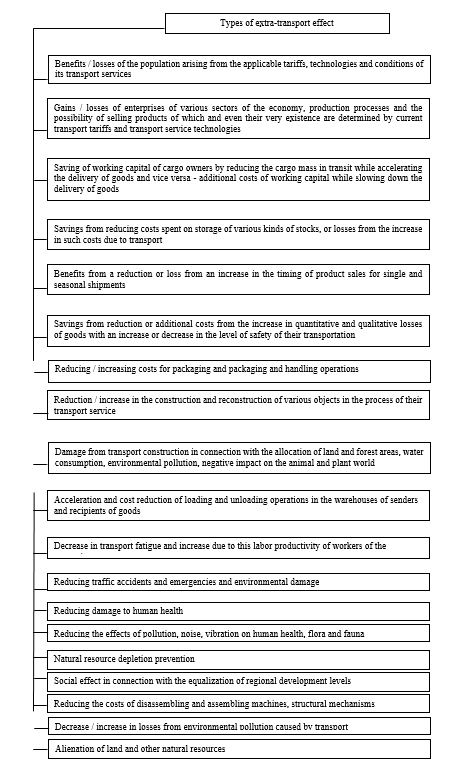
Findings
In modern conditions, the extra-transport effect is to evaluate and take into account when determining the public effectiveness of investment projects related to the development of transport. This type of efficiency is determined in cases: 1) justification of measures for industrial development and socio-economic development of new regions; 2) the choice of options for improving transport services based on a comparison of options that meet the interests of the territory in different ways; 3) substantiation of the sizes and forms of state support of measures for the development of transport ( Kuzina & Vasilenko, 2017).
Conclusion
It can be concluded that the methods of accounting for a number of types of extra-transport effect (damage) to identify the competitiveness of the mode of transport should be different in determining the commercial and public effectiveness of the options being evaluated, depending on the level of economic structures at which the transport option is selected. Therefore, it is advisable to further improve the accounting for extra-transport effects in determining the competitiveness of transport facilities, transportation or events during the modernization period and the entire transport complex.
References
- Balashova, I. V., Lipkina, A. V., & Balashova, E. S. (2015). Innovative restructuring as a tool for adapting the economic system. Problems of the development of modern science. Collection of articles of the international scientific-practical conference. Part 1. (pp. 21–23) Ufa: Aeterna.
- Bugreev, N. V. (2013). Description of modern methods for assessing the competitiveness of transport products. Bulletin of Tula State University. Econ. and legal sci., 2-1, 54–58.
- Kravchenko, L. A., Perchatkin, D. S., & Laptiev, A. Y. (2017). The competitiveness of Russian Railways in the market of transport and logistics services. Symbol of Science, 03-1, 78–80.
- Kuzina, E. L. (2010). Ecological and economic substantiation of decision-making on sustainable development of urban areas in the areas of functioning of the railway system. Rostov-on-Don, Russian State Social University.
- Kuzina, E. L., & Vasilenko, M. A. (2017). Еnterprise Competitiveness and ecological safety: problems and ways of their solution. Retrieved from ivdon.ru/ru/magazine/archive/n3y2017/4293
- Sokolov, Y. I. (2008). Product quality management in railway transport. Moscow, MIIT.
- Tereshina, N. P., Abramov, A. P., Galaburda, V. G., & Ryshkov, A. V. (2002). Methods for assessing the competitiveness of transport products, taking into account the extra-transport effect. Econ. of railway transp., 4, 22–23.
- Uskov, N. S. (2010). On the need to ensure a positive extra-transport effect in the new economy. Materials of the fourth international conference Management of the development of large-scale systems mlsd'2010. (p. 178–180). Moscow: Establishment of the Russian Academy of Sciences Institute of Management Problems V.A. Trapeznikova.
- Vasilenko, M A., Drozdov, N. A., Tagiltseva, Y. A., Kuzina, E. L., & Kuzina, M. A. (2017). Systematic approach and advanced marketing in public-private partnerships. 2017 International Conference "Quality Management,Transport and Information Security, Information Technologies" (IT&QM&IS), St. Petersburg (pp. 27-31). https://doi.org/10.1109/ITMQIS.2017.8085753
- Vasilenko, M. A., & Kuzina, E. L. (2017). Methods in managing the competitiveness of corporations. Retrieved from http://www.ivdon.ru/ru/ma gazine/archive/N3y2017/4283
Copyright information

This work is licensed under a Creative Commons Attribution-NonCommercial-NoDerivatives 4.0 International License.
About this article
Publication Date
31 October 2020
Article Doi
eBook ISBN
978-1-80296-091-4
Publisher
European Publisher
Volume
92
Print ISBN (optional)
-
Edition Number
1st Edition
Pages
1-3929
Subjects
Sociolinguistics, linguistics, semantics, discourse analysis, translation, interpretation
Cite this article as:
Vasilenko, M. A., Kuzina, E. L., Alexeevich, D. N., Kuzina, E. L., Alexandrovna, V. E., & Evgenievich, S. E. (2020). Extra-Transport Effect In Choice Of Methods For Assessment Of Transport Competitiveness. In D. K. Bataev (Ed.), Social and Cultural Transformations in the Context of Modern Globalism» Dedicated to the 80th Anniversary of Turkayev Hassan Vakhitovich, vol 92. European Proceedings of Social and Behavioural Sciences (pp. 2585-2593). European Publisher. https://doi.org/10.15405/epsbs.2020.10.05.342

